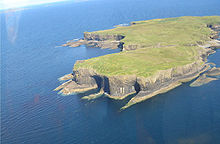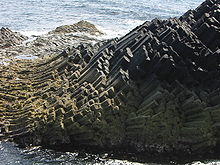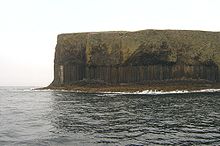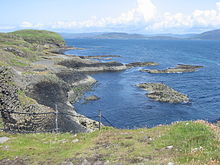- Staffa
-
Staffa Location Staffa shown within Scotland OS grid reference NM323355 Names Gaelic name Stafa Norse name stafi-oy Meaning of name Old Norse for 'stave or pillar island'. Area and summit Area 33 hectares (0.13 sq mi) Area rank 0 Highest elevation 42 metres (138 ft) Population Population Uninhabited since 1800 Groupings Island group Mull Local Authority Argyll and Bute 

References [1][2][3] If shown, area and population ranks are for all Scottish islands and all inhabited Scottish islands respectively. Population data is from 2001 census. Staffa (Scottish Gaelic: Stafa,[3][4] pronounced [s̪t̪afa]) from the Old Norse for stave or pillar island, is an island of the Inner Hebrides in Argyll and Bute, Scotland. The Vikings gave it this name as its columnar basalt reminded them of their houses, which were built from vertically placed tree-logs.[5]
Staffa lies about 10 kilometres (6.2 mi) west of the Isle of Mull. The area is 33 hectares (0.13 sq mi)[6] and the highest point is 42 metres (138 ft) above sea level.
The island came to prominence in the late 18th century after a visit by Sir Joseph Banks. He and his fellow travellers extolled the natural beauty of the basalt columns in general and of the island's main sea cavern which Banks re-named 'Fingal's Cave'. Their visit was followed by that of many other prominent personalities throughout the next two centuries, including Queen Victoria and Felix Mendelssohn. The latter's Hebrides Overture brought further fame to the island, which was by then uninhabited. It is now in the care of the National Trust for Scotland.[7]
Contents
Geology and pre-history
In pre-historic times Staffa was covered by the ice sheets which spread from Scotland out into the Atlantic Ocean beyond the Outer Hebrides. After the last retreat of the ice around 20,000 years ago, sea levels were up to 125 metres (410 ft) lower than at present. Although the isostatic rise of land makes estimating post-glacial coastlines a complex task, c. 14,000 BP it is likely that Staffa was a larger island, just off the coast of mainland Scotland, which at that time would have included what is now the Isle of Mull, Iona and the Treshnish Isles.[8]
Steadily rising sea levels since that time then further isolated this little island, which is entirely of volcanic origin. It consists of a basement of tuff, underneath colonnades of a black fine-grained Tertiary basalt, overlying which is a third layer of basaltic lava lacking a crystalline structure. By contrast, slow cooling of the second layer of basalt resulted in an extraordinary pattern of predominantly hexagonal columns which form the faces and walls of the principal caves.[1] The lava contracted towards each of a series of equally spaced centres as it cooled and solidified into prismatic columns, a process known as columnar jointing. The columns typically have three to eight sides, six being most common. The columns are also divided horizontally by cross joints.[9] Similar formations are found at the Giant's Causeway in Northern Ireland, on the island of Ulva and Ardmeanach on the Isle of Mull.[7] Grooves in the roof of MacKinnon's cave indicate either a pyroclastic flow or a series of eroded ash falls in the rock above the columnar basalt.[10] The 'Staffa Group' is the name given to the series of olivine tholeiite basalts found in the vicinity of Mull which erupted 55–58 million years ago.[11]
Geography
Staffa lies about 10 kilometres (6 mi) west of Mull, and 9 km northeast of Iona. It is longitudinally oriented north-south, and is a kilometre long by about half a kilometre wide. The circumference is about 3.8 km in extent. In the northeast the isle shelves to a shore, but otherwise the coast is rugged and much indented, numerous caves having been carved out by rain, stream and ocean. There is enough grass on the surface to feed a few cattle, and the island contains a spring.
On the east coast are Goat Cave and Clamshell Cave. The latter is 10 m high, about 6 m wide at the entrance, some 45 m long, and on one side of it the ridges of basalt stand out like the ribs of a ship. Near this cave is the pyramidal rock islet of Am Buachaille ('The Herdsman'), a pile of basalt columns fully seen only at low tide. Other outlying rocks include Eilean Dubh to the north-west and a series of skerries stretching for half a kilometre to the south-west. On the southwest shore are Boat Cave and Mackinnon’s Cave (named after an 15th-century abbot of Iona), which has a tunnel connecting it to Cormorant Cave. These caves lie to the south-west and can be accessed from the bay of Port an Fhasgaidh at low tide. In 1945 a mine exploded near Boat Cave causing damage to the cliff face which is still visible.[1] At 107 metres, Mackinnon's Cave is the 79th longest sea cave in the world.[12]
Staffa's most famous feature is Fingal's Cave, a large sea cave located near the southern tip of the island some 20 m high and 75 m long formed in cliffs of hexagonal basalt columns. This cliff-face is called the Colonnade or The Great Face and it was these cliffs and its caves that inspired Felix Mendelssohn's Die Hebriden (English: Hebrides Overture opus 26),[13] which was premiered in London in 1832.[14] The original gaelic name for Fingal's Cave is An Uamh Bhin – "the melodious cave" – but it was subsequently renamed after the 3rd-century Irish warrior Fionn MacCool.[1][15][16] Mendelssohn was nonetheless inspired by the sound of the waves in the cave and waxed lyrical about his visit, claiming that he arrived in Scotland: "with a rake for folk-songs, an ear for the lovely, fragrant countryside, and a heart for the bare legs of the natives."[17]
Staffa is part of the Loch Na Keal National Scenic Area, one of 40 in Scotland.[18]
History
 Engraving based on sketches made of Fingal's Cave by John Cleveley Jnr. originally published in 1772[19]
Engraving based on sketches made of Fingal's Cave by John Cleveley Jnr. originally published in 1772[19]
18th century
Little is known of the early history of Staffa, although the Swiss town of Stäfa on Lake Zurich was named after the island by a monk from nearby Iona.[1] Originally part of the Ulva estate of the MacQuarries until 1777, it was brought to the English-speaking world's attention after a visit by Sir Joseph Banks in August 1772. En route to Iceland in the company of the painter Johann Zoffany, the Bishop of Linköping, and a Dr. Solander, Banks, (later a president of the Royal Society) was entertained by Maclean of Drummen, on the Isle of Mull. Hearing about Staffa he resolved to visit and set out from Tobermory the next day. The winds were light and they did not arrive until darkness had fallen.[20][21] Banks wrote:
It was too dark to see anything, so we carried our tent and baggage near the only house on the island, and began to cook our suppers, in order to be prepared for the earliest dawn, and to enjoy that which, from the conversation of the gentlemen we had, now raised the highest expectations of.[22]
They were not disappointed. Despite becoming infested with lice during his short stay on the island, he provided glowing reports of his visit.[1] He confessed that he was:
forced to acknowledge that this piece of architecture, formed by nature, far surpasses that of the Louvre, that of St. Peter at Rome, all that remains of Palmyra and Paestum, and all that the genius, the taste and the luxury of the Greeks were capable of inventing.[7][23]
Samuel Johnson and his protege James Boswell visited The MacQuarrie on Ulva in 1773, the year after Banks' visit. Perhaps aware that Banks considered that the columnar basalt cliff formations on Ulva called "The Castles" rivalled Staffa's[24] Johnson wrote:
When the islanders were reproached with their ignorance or insensibility of the wonders of Staffa, they had not much to reply. They had indeed considered it little, because they had always seen it; and none but philosophers, nor they always, are struck with wonder otherwise than by novelty.[25]
Amongst the first[26] eminent overseas visitors to Staffa were Barthélemy Faujas de Saint-Fond, a wealthy French zoologist and mineralogist and the American architect and naturalist William Thornton. Visiting in 1784, they were suitably impressed, Faujus writing: "this superb monument of nature, which in regard to its form bears so strong a resemblance to a work of art, though art can certainly claim no share in it."[27]
19th and 20th centuries
Subsequently a stream of famous visitors came to view Staffa's wonders including Robert Adam, Sir Walter Scott (1810), John Keats (1818), J. M. W. Turner, whose 1830 visit yielded an oil painting exhibited in 1832, William Wordsworth (1833), Jules Verne (1839), Alice Liddell (the inspiration for Alice in Wonderland) in 1878, David Livingstone (1864), Robert Louis Stevenson (1870) and Mendelssohn himself in 1829.[7][28] Wordsworth, however, found the volume of tourism disappointing.
We saw, but surely in the motley crowd
- Not one of us has felt, the far-famed sight:
- How could we feel it? Each the others blight,
- Hurried and hurrying volatile and loud.
William Wordsworth, Cave of Staffa. Poems Composed or Suggested During a Tour in the Summer of 1833. No 28.[29]Writing more than a century later the writer W. H. Murray agreed, complaining that the visitors spoiled the "character and atmosphere", and rather stand-offishly suggesting that "to know Staffa one must go alone".[30]
Others were more enthusiastic, despite the presence of numerous others. Queen Victoria and Prince Albert were rowed into the cave in the royal barge in 1847,[31][32] and The Times correspondent recorded:
As the Royal Squadron cleared out of the Sound of Mull, and round the northern extremity of the island, a noble prospect lay before it, the steep and barren headlands of Ardnamurchan stretching away into the Atlantic on the right, on the left the precipitous cliffs of the Mull coast, and far away and embosomed in the ocean, the fantastic and varied forms of the adjacent islands. The horizon toward the north was a good deal obscured by haze, but, notwithstanding, Skye was distinctly visible... The deserted and solitary aspect of the island was brought out with a strange and startling effect by the presence of so many steamers; and as Her Majesty's barge with the Royal Standard floated into the cave, the crew dipping their oars with the greatest precision, nothing could be more animated and grand than the appearance which the vast basaltic entrance, so solemn in its proportions, presented.[33]
Keats complained about the expense of the ferry, but was captivated by what he saw nonetheless. Displeased with his first efforts to describe this "cathedral of the sea" he finally settled on:
Not Aladdin magian/Ever such a work began, Not the wizard of the Dee, Ever such a dream could see; Not St John, in Patmos Isle, In the passion of his toil, When he saw the churches seven, Golden Aisl'd, built up in heaven, Gazed at such a rugged wonder. --John Keats, Staffa[34][35]
Tenants and owners
However inspiring the scenery, it was not an easy place to live. In 1772 there was but a single family living on a diet of barley oats, flax and potatoes, and whatever their grazing animals could provide.[1] By the end of the 18th century they had deserted Staffa, apparently terrified by the severity of winter storms.[7] Signs of "rig and furrow" agriculture can still be seen on the island but the only surviving building is the ruin of a 19th century shelter for travellers.[36] By 1800 the island was under the ownership of Colin MacDonald of Loch Boisdale. In 1816 it was sold by his son Ranald MacDonald into the care of Trustees. In 1821 these Trustees sold to Alexander Forman as Trustee, the purchase money being paid by his brother John Forman WS. It remained in the Forman family until sold by Bernard Gilpin Vincent "Pat" Forman in 1968. There were several private owners after that, including Alastair de Watteville, a descendant of Colin MacDonald[1] who wrote a book about the island,[37] until finally it was gifted to the National Trust for Scotland by Jock Elliot Jr. of New York in 1986 as an imaginative way to honour the 60th birthday of his wife, Eleanor. A grateful National Trust bestowed upon her the honorific "Steward of Staffa".[38] In a 2005 poll of Radio Times readers, Staffa was named as the 8th greatest natural wonder in Britain.[39]
During the 20th century there have been issues of bogus postage stamps bearing Staffa's name.[40]
Wildlife
In 1800 there were three Red Deer on the island, later replaced by goats and then a small herd of black cattle.[1] Subsequently the summer grazing was used for sheep by crofters from Iona but in 1997 all livestock was removed. This has led to a regeneration of the island's vegetation.[36]
Puffin, Black-legged Kittiwakes, Common Shag and gulls nest on the island and the surrounding waters provide a livelihood for numerous seabirds, Gray Seals, dolphins, Basking Sharks, Minke, and Pilot Whales.[36]
Visiting Staffa
Boat trips from Oban, Dervaig on Mull, Fionnphort and Iona allow visitors to view caves and the puffins that nest on the island between May and September.[41]
There is a landing place used by the tourist boats just north of Am Buachaille, but disembarkation is only possible in calm conditions. The island lacks a genuine anchorage.[1]
See also
Notes
- ^ a b c d e f g h i j Haswell-Smith (2004) pp 124–27.
- ^ Ordnance Survey 1:50,000 First Series (1976) Sheet 48
- ^ a b Mac an Tàilleir, Iain, (2003) "Placenames P-Z" (pdf) Edinburgh. Pàrlamaid na h-Alba. Retrieved 8 June 2008.
- ^ "Staffa" Sabhal Mòr Ostaig. Retrieved 27 July 2008.
- ^ Murray (1973) p 44.
- ^ This is Haswell-Smith's estimate. Keay (1994) states 28 ha.
- ^ a b c d e Keay & Keay (1994) p 894.
- ^ Murray (1973) p 69.
- ^ Mitchell, Colin and Mitchell, Patrick (2005) Landform and Terrain: The Physical Geography of Landscape Brailsford Press. ISBN 1904623565 3.pdf
- ^ "To Staffa with Ladder" (September 2006)Grampian Speleological Group Newsletter Number 128. Retrieved 9 September 2008.
- ^ Bell, B.R. and Jolley, D.W. (1997) Application of palynological data to the chronology of the Palaeogene lava fields of the British Province: implications for magmatic stratigraphy. Journal of the Geological Society. London. Vol. 154, pp. 701–708.
- ^ Long Sea Caves of the World Retrieved 14 April 2007. Note however that the list only features entries from North America, Hawaii, and Europe.
- ^ FINGAL'S CAVE, OPUS 26, Program Notes by Rita Junker Pickar, 2002, Retrieved 21 October 2010.
- ^ Program Notes: Mendelssohn: "Hebrides" Overture by Geoff Kuenning ucla.edu. Retrieved 10 December 2006.
- ^ Keay & Keay (1994) state that the re-naming was done by Banks, although showcaves.com states that Mendelssohn is blamed for the "misnaming".
- ^ Bray (1996) p 92 notes that James Macpherson's Fingal, an Ancient Epic Poem was a "runaway bestseller" in many European countries at the time, and that Banks may later have regretted his choice when it became clear that Macpherson's claims to have translated the work from an ancient Gaelic manuscripts proved to be bogus.
- ^ The New Encyclopedia Britannica (1978) Chicago. Encyclopedia Britannica Inc.
- ^ "National Scenic Areas". SNH. Retrieved 30 Mar 2011.
- ^ Cleveley accompanied Pennant (1772) on his voyage.
- ^ Bray (1996) pp 89–90.
- ^ Bray (1996) p 89 suggests that Banks' companion was a Bishop of Iceland, but this seems unlikely as Cooper (1979) provides him with a name and a bishopric - see note below.
- ^ Pennant, Thomas (1772) A Tour of Scotland and a Voyage to the Hebrides. London. Benjamin White. Quoted in Bray (1996) page 90.
- ^ However, Cooper (1979) p 26 is unequivocal in stating that this "hyperbole" was penned by The Bishop of Linköping, Uno von Troil, who accompanied Banks.
- ^ MacNab, Peter (1993) Mull and Iona: Highways and Byways. Edinburgh. Luath Press. pp 72–73
- ^ Johnson, Samuel (1775) A Journey to the Western Islands of Scotland. London. Chapman & Dodd. (1924 edition).
- ^ In fact Cooper (1979) p 16 states that Faujus was the first such person to be attracted to the Hebrides, but then later (p 26) refers to a prior visit by Uno von Troil in the company of Banks. Perhaps he did not consider Swedish bishops to be sufficiently important to merit this accolade.
- ^ Faujus de Saint Frond, B. A Journey through England and Wales to the Hebrides in 1784, edited by Sir Archibald Geikie (1907) and quoted in Cooper (1979) p 17.
- ^ Cooper (1979) pp 52–54.
- ^ “Poems Composed or Suggested During A Tour In The Summer Of 1833 XXVIII. Cave Of Staffa” Bartleby.com. Retrieved 3 May 2007.
- ^ Murray, W.H. (1966) The Hebrides. London. Heinemann. p 109.
- ^ Cooper (1979) p 100.
- ^ Keay & Keay (1994) state 1836, which is unlikely.
- ^ The Times correspondent writing in the Illustrated London News (1847), quoted in Bray (1996) page 244.
- ^ Cooper (1979) p 53.
- ^ Bray (1996) page 88, suggests that both Keat's and Wordsworth's attempts are "rather poor verse" and it is hard to disagree.
- ^ a b c "Staffa" Scottish Natural Heritage. Retrieved 10 December 2006.
- ^ de Watteville, Alastair (1993) The Island of Staffa: Its Astonishing Rock Formations Include World-renowned Fingal's Cave. Romsey Fine Art.
- ^ Obituaries: Eleanor Elliot (8 December 2006) The Scotsman newspaper. Edinburgh.
- ^ Report of poll result BBC.co.uk Retrieved 10 December 2006.
- ^ "Bogus Issues" International Society of Worldwide Stamp Collectors. Retrieved 14 April 2007.
- ^ "Fingal's Cave: Uamh-Binn - The Cave of Melody" Show Caves of the World. Retrieved 10 December 2006.
Bibliography
- Bray, Elizabeth (1996) The Discovery of the Hebrides: Voyages to the Western Isles 1745-1883. Edinburgh. Birlinn.
- Cooper, Derek (1979) Road to the Isles: Travellers in the Hebrides 1770-1914. London. Routledge & Kegan Paul.
- Haswell-Smith, Hamish. (2004) The Scottish Islands. Edinburgh. Canongate.
- Keay, J. & Keay, J. (1994) Collins Encyclopaedia of Scotland. London. HarperCollins.
- Murray, W.H. (1973) The Islands of Western Scotland. London. Eyre Methuen.
External links
- The Wrath of Staffa - video blog about a rainy expedition to Staffa
- National Trust for Scotland: Fingal's Cave
Mull Main settlements 
Smaller settlements Geographical features History Local culture and economy Surrounding islands Calve Island · Dubh Artach · Eorsa · Erraid · Gometra · Inch Kenneth · Iona · Little Colonsay · Samalan Island · Skerryvore · Staffa · Torran Rocks · Treshnish Isles · Ulva ·Inhabited islands of the Hebrides Inner Hebrides 
Outer Hebrides Baleshare · Barra · Benbecula · Berneray · Eriskay · Flodaigh · Fraoch-eilean · Great Bernera · Grimsay (North) · Grimsay (South) · Lewis and Harris · North Uist · Scalpay · South Uist · VatersayIslands of Scotland Northern Isles 
Hebrides Other Categories:- Islands of the Inner Hebrides
- National Nature Reserves in Scotland
- National Trust for Scotland properties
- Uninhabited islands of Scotland
- Sites of Special Scientific Interest in Mull, Coll and Tiree
- Argyll and Bute
- Volcanoes of Scotland
- Paleogene volcanism
- Extinct volcanoes
- Columnar basalts
Wikimedia Foundation. 2010.











